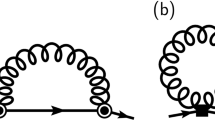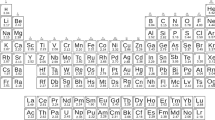Abstract
CERTAIN systems of bands obtained in zinc, cadmium, and mercury vapours are considered by Kratzer1, on account of the large spacing of the structure lines and the corresponding small moments of inertia, to be very probably due to hydrides of the respective elements. The same conclusion has been indicated in the case of copper by Frerichs2, who has recently measured the lines of several copper bands of this type under high dispersion.
This is a preview of subscription content, access via your institution
Access options
Subscribe to this journal
Receive 51 print issues and online access
$199.00 per year
only $3.90 per issue
Buy this article
- Purchase on Springer Link
- Instant access to full article PDF
Prices may be subject to local taxes which are calculated during checkout
Similar content being viewed by others
References
Ann. der Physik, 71, 102 (1923).
Zeit. für Physik, 20, 170 (1923). Similar but less accurate and complete data have been obtained by Bengtsson, Zeit. für Physik, 20, 229 (1923).
Frerichs gives no data on relative intensities of the doublet components, so that this point cannot be checked here.
Of the other bands measured by Frerichs, three should show larger isotope effects than 428o and 4328. Of these 4380 was so weak that it could be measured only with a wide slit, while in the case of 465O and 4690 the “lines appear broadened and unsharp due to the continuous background, making measurement difficult"; however, an apparent doubling of the lines from m = 12 on was noted (but not measured) in the case of 465O.
Hg, Liese, Zeit. wiss. Phot. 11, 349 (1913). Zn, Hulthén, Compt. rend. 173, 524 (1921). Cd. Hulthén and Bengtsson, Compt. rend., 175, 123 (1922). The results are given to tenths of a wave-number unit.
Zn has isotopes 64, 66, 68, 70, according to Dempster; Hg, (197–200), 202, 204, according to Aston; Cd undoubtedly has several isotopes, although they have not yet been determined experimentally.
A possible doubt in the case of Hg is pretty well allayed by the similarity of the bands to those of Zu and Cd.
For references, see Kayser's “Handbuch der Spektroskopie.”
Probably both diatomic and triatomic hydrides occur as emitters. The HCu bands have a simple structure very similar to that of the HC1 absorption bands. The MgH2 bands (cf. Sommerfeld, “Atombau”, 3rd edit, p. 544) are more complex, and are closely analogous to the OH2 bands.
Author information
Authors and Affiliations
Rights and permissions
About this article
Cite this article
MULLIKEN, R. The Isotope Effect as a Means of identifying the Emitters of Band Spectra: Application to the Bands of the Metal Hydrides. Nature 113, 489–490 (1924). https://doi.org/10.1038/113489a0
Issue Date:
DOI: https://doi.org/10.1038/113489a0
This article is cited by
-
Gli Spettri di Bande e L’isotopia
Il Nuovo Cimento (1932)
Comments
By submitting a comment you agree to abide by our Terms and Community Guidelines. If you find something abusive or that does not comply with our terms or guidelines please flag it as inappropriate.



